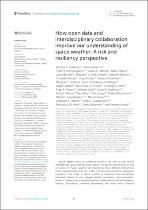How open data and interdisciplinary collaboration improve our understanding of space weather: A risk and resiliency perspective
| dc.contributor.author | Ledvina, Vincent E. | |
| dc.contributor.author | Palmerio, Erika | |
| dc.contributor.author | Snow, Martin | |
| dc.date.accessioned | 2023-03-22T07:39:44Z | |
| dc.date.available | 2023-03-22T07:39:44Z | |
| dc.date.issued | 2022 | |
| dc.identifier.citation | Ledvina, V. E. et al. (2022). How open data and interdisciplinary collaboration improve our understanding of space weather: A risk and resiliency perspective. Frontiers in Astronomy and Space Sciences, 9, 1067571. https://doi.org/10.3389/fspas.2022.1067571 | en_US |
| dc.identifier.issn | 2296-987X | |
| dc.identifier.uri | https://doi.org/10.3389/fspas.2022.1067571 | |
| dc.identifier.uri | http://hdl.handle.net/10566/8621 | |
| dc.description.abstract | Space weather refers to conditions around a star, like our Sun, and its interplanetary space that may affect space- and ground-based assets as well as human life. Space weather can manifest as many different phenomena, often simultaneously, and can create complex and sometimes dangerous conditions. The study of space weather is inherently trans-disciplinary, including subfields of solar, magnetospheric, ionospheric, and atmospheric research communities, but benefiting from collaborations with policymakers, industry, astrophysics, software engineering, and many more. | en_US |
| dc.language.iso | en | en_US |
| dc.publisher | Frontiers Media | en_US |
| dc.subject | Astronomy | en_US |
| dc.subject | Physics | en_US |
| dc.subject | Astrophysics | en_US |
| dc.subject | Open science | en_US |
| dc.subject | Open data | en_US |
| dc.title | How open data and interdisciplinary collaboration improve our understanding of space weather: A risk and resiliency perspective | en_US |
| dc.type | Article | en_US |

